Embroidery Thread Types: A Guide to Choosing the Right One
Embroidery opens up a world of creative possibilities, but the vast array of available fibers can be overwhelming. Selecting an unsuitable floss or yarn can lead to frustrating tangles, broken stitches, and projects that lack a professional finish.
For beginners and even seasoned stitchers, matching the right material to a project can be confusing. This guide is here to help! We’ll demystify the different types of materials, explain which are best for your projects, and provide practical tips for smoother stitching. Boost your confidence and create stunning, high-quality needlework every time!
1. Understanding embroidery thread: A beginner’s guide
The true beauty of needlework emerges not just from skilled hands or fancy equipment, but fundamentally from a thoughtful choice of fiber. This unique material is specifically crafted for the art of stitching, with incredible diversity in textures, colors, and weights. Ultimately, selecting the right medium has the power to elevate a project from ordinary to truly stunning, making a significant impact on its overall quality.
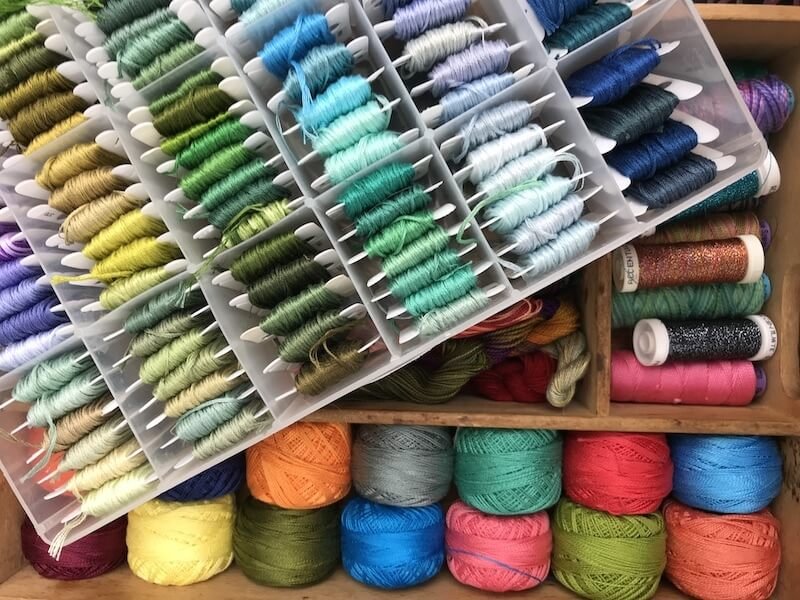
2. Exploring hand embroidery thread types: From cotton to silk
Hand stitching offers incredible creative possibilities, and choosing the right fiber is your most valuable tool. Let’s explore some of the most popular options, from versatile cottons to luxurious silks.
2.1 The versatile stranded cotton (embroidery floss)
Stranded floss is truly the go-to for hand needlework. It’s incredibly versatile and widely used. Indeed, it’s ideal for cross-stitch, but also excels in needle painting, needlepoint, and general decorative stitching.
Typically sold in skeins of 8 1/2 yards, this material is made up of 6 separable strands. This unique feature allows you to adjust its thickness easily by strand separation. For instance, for fine details like monograms on delicate fabrics, use just 1-2 strands.
Conversely, for bolder designs on heavier materials, utilize 3-6 strands. While the most common fiber is cotton-based, you can also find rayon and silk floss options, each offering a different sheen and feel.
For reliable quality and a vast color range, look to brands like DMC, Anchor, and Cosmo. For truly unique colors, consider specialty dyed options, such as variegated skeins from brands like Weeks Dye Works or Valdani.
2.2 Textured elegance: Perle cotton
For a different look, consider perle cotton. This textured material is heavier and comes as a single, non-divisible strand with a distinct twisted appearance. Its weights are indicated by numbers, and remember, the numbering works inversely: a higher number means a finer filament, while a lower number indicates a thicker one.
A medium weight, like perle #5 or #8, is a fantastic all-purpose choice, especially for beginners. It’s perfectly suited for Hardanger, cross stitch, redwork, crazy quilting, and canvas work.
This S-twisted, 2-ply yarn has a high sheen that adds noticeable dimension to your stitchwork. You can rely on DMC and Anchor for consistent quality and color.
2.3 Shiny and vibrant: Rayon floss (satin thread)
If you desire maximum shine, rayon floss, also known as satin thread, is your answer. It offers a silk-like sheen and is the ideal choice for achieving incredibly vibrant colors. While it shares a similar format to stranded cotton, its shine and overall appearance are distinctly different.
However, be aware that it can be prone to tangling. To minimize this, it’s wise to use shorter lengths, around 12-18 inches. Using a conditioner or slightly dampening the floss can also help reduce friction.
2.4 Adding sparkle: Metallic hand embroidery thread
To introduce shimmer and highlights, metallic fibers are ideal. They are perfect for goldwork and adding special accents to your designs. However, be mindful that this type of material can be prone to tarnishing, tangling, snagging, and fraying.
Synthetic metallic options are more resistant to tarnishing. To combat fraying, a helpful technique is to use a needle with a larger eye, which helps minimize friction. Working slowly, using shorter lengths, and considering a lubricant can also make working with these shiny filaments smoother.
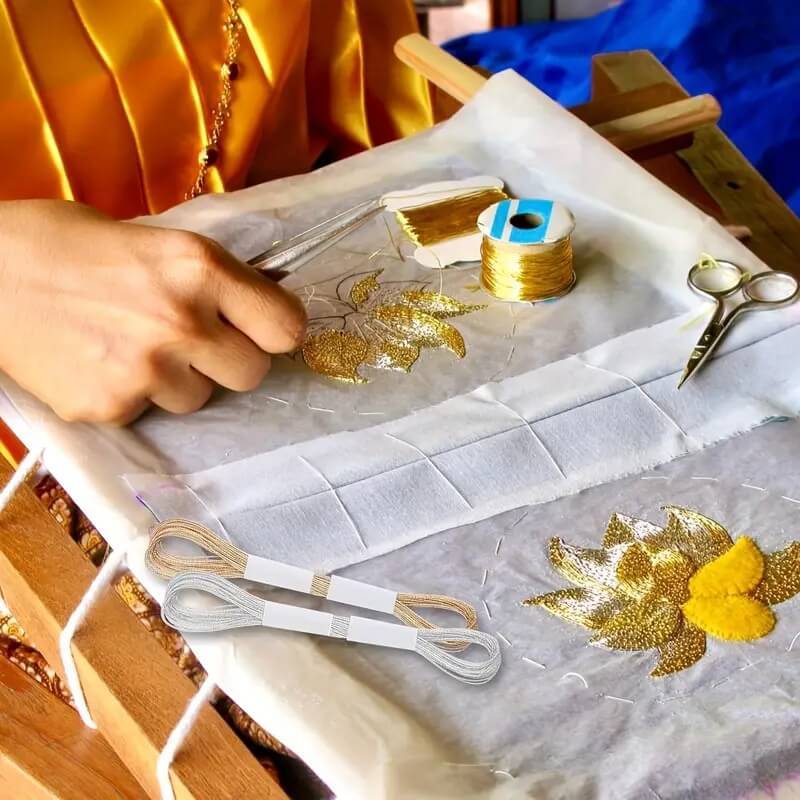
2.5 Warmth and texture: Crewel yarn/wool
For a warmer, more textured look, consider crewel yarn, also known as wool embroidery thread. This is typically a fine wool or acrylic yarn, often 2-ply, and is used in wool work, needlepoint, and tapestry projects.
Its thickness is generally similar to about two strands of standard floss, offering a substantial yet manageable weight. For finer work, strand separation is possible with some crewel yarns.
2.6 Heavy duty: Tapestry yarn/Persian yarn
For projects needing extra durability, consider tapestry or Persian yarn. Tapestry yarn is a thick, 4-ply wool known for its durability and non-separable strands, making it ideal for canvas work and needlepoint on heavy fabrics.
Persian yarn, in contrast, is a more loosely twisted 3-strand material, often made of wool or acrylic, and features separable strands for adjustable thickness. Both are excellent choices for durable projects that will see a lot of use, such as cushions or wall hangings.
2.7 Fuzzy and unique: Felted wool yarn
For a truly distinctive texture, explore felted wool yarn. This fuzzy material is made of 100% pure wool that has undergone a felting process, resulting in a unique texture. Often used for couching, it adds significant dimension and a rustic, handcrafted feel to your projects.
2.8 Luxurious sheen: Silk threads
For unparalleled luxury, silk fibers are the epitome of elegance. They offer a beautiful sheen and come in brilliant colors, perfect for when you want a truly special finish.
They are available as both flat silk (with minimal twist) and twisted floss options. However, be aware that fading and color bleeding can be concerns. Therefore, it’s crucial to handle them with care and always test for colorfastness before starting your project. To enhance the natural sheen, lightly steam press the back of your finished work.
2.9 Thick and varied: Knitting yarn for embroidery
Don’t overlook knitting yarn! It comes in a wide range of weights, making some thicker varieties suitable for bold needlework designs and for quickly filling in large areas. Knitting yarn can bring a chunky, cozy texture to your projects, making it ideal for home décor.
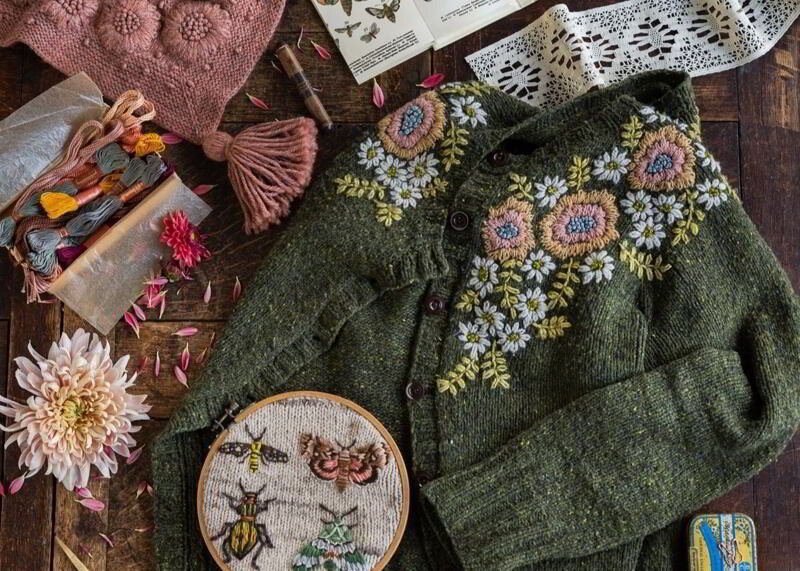
2.10 Colorful variety: Variegated or multi-color threads
For built-in color variation, choose variegated or multi-color skeins. These products, sometimes called ombre or color-changing, feature multiple shades of the same color or different colors within a single length.
They are available in various fibers, including cotton, silk, and rayon, and effortlessly add color depth and visual interest through their gradual gradients.
2.11 Strong and functional: Cord & beading thread
For functional and decorative purposes, explore cord and beading supplies. Cord is versatile, used for couching, jewelry making, and general crafting.
For beading, strong nylon filament is a durable choice. For jewelry and macrame, consider waxed cotton cord and polyester stretch cord. For delicate beadwork where invisibility is key, a transparent polyester beading cord is an excellent option.
2.12 Delicate and floral: Ribbons for embroidery
For a uniquely dimensional effect, use ribbons in your needlework. This technique creates wonderfully textured floral designs and other decorative elements. Silk and satin ribbons are particularly effective for adding a touch of elegance and realism to floral pieces.
2.13 Sheen and structure: Crochet thread
While primarily for crochet, this material can also be used in decorative stitching for a special effect. Also used for string art, it has a beautiful luster and can create a unique textured effect compared to traditional floss.
2.14 Strong and durable: Sashiko thread
Specifically designed for Japanese Sashiko, this fiber is a must for the technique. It is thicker and stronger than standard floss, with a distinctive twist that contributes to its durable nature.
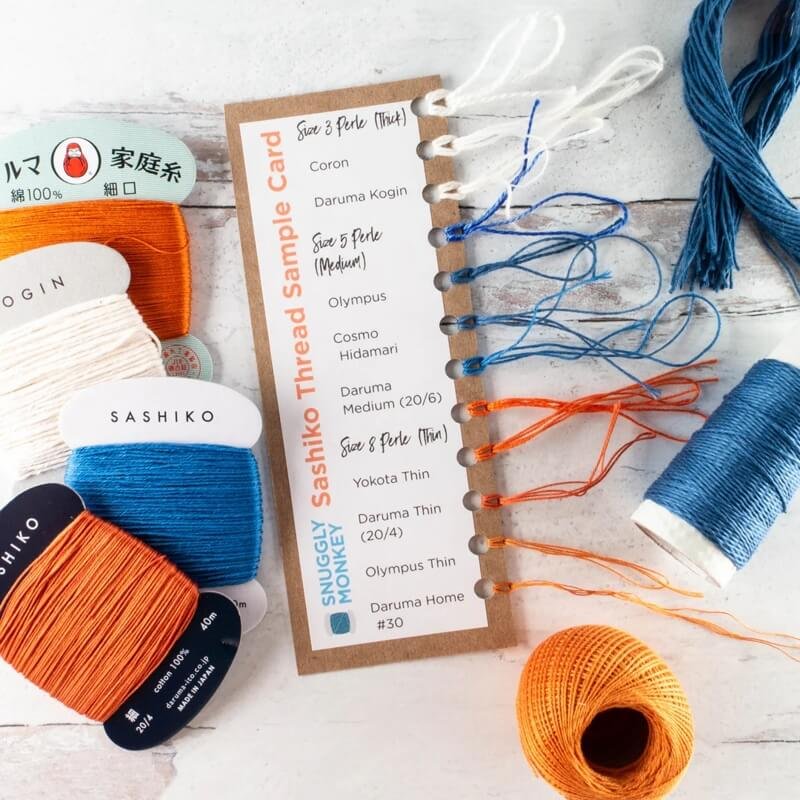
2.15 Smooth and lustrous: Cotton floche thread
If the goal is a smooth, luxurious finish, cotton floche is an excellent option. This non-divisible, single-ply material possesses a naturally beautiful sheen. Because of its smooth texture, it is particularly well-suited for satin stitch, monogramming, and whitework, especially in heirloom sewing projects.
2.16 Glow-in-the-dark fun: Light effects embroidery thread
For novelty and fun, glow-in-the-dark thread is a unique choice. This novelty material is typically made of 100% polyester and has a shiny appearance even in regular light. Crucially, it is colorfast and tarnish-resistant, ensuring the effect lasts.
2.17 Classic whitework: Coton a Broder
For traditional whitework, Coton a Broder is a classic choice. Also known as “cutwork thread,” this soft cotton fiber has a lovely sheen and a tighter twist than floche. It is specifically used for cutwork, monogramming, Schwalm embroidery, and other whitework techniques.
2.18 Matte cotton: Danish flower thread
Another matte option is Danish flower thread. This soft fiber has a matte finish and a tighter twist than floche. In terms of weight, it is approximately equivalent to two strands of DMC floss and is available in a wide range of colors.
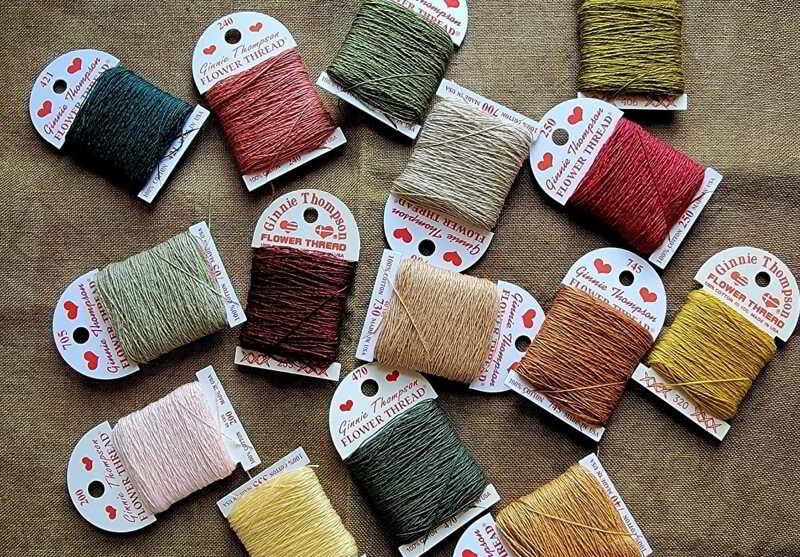
2.19 Traditional Mountmellick thread
For a specific historical style, use Mountmellick thread. This white cotton material is designed for the technique of the same name and has a matte finish. It is a firmly twisted, traditional fiber that comes in sizes ranging from very fine to heavy, providing a nice contrast when used on cotton sateen fabric.
2.20 Historical silk: Filoselle
For a touch of history, consider Filoselle. This historical fiber is a type of silk floss made from leftover reeled silk waste. Filoselle is a vintage option, offering a glimpse into needlework traditions of the past.
2.21 Lightweight wool: Medici
Lastly, Medici thread was a fine, lightweight wool option manufactured by DMC. It’s important to note that this particular yarn is now discontinued. While you may still find vintage skeins, it is no longer in production and represents a piece of embroidery history.
3. Machine embroidery threads: Speed and precision
When it comes to machine embroidery, the choice of material is crucial for both speed and achieving precise, durable results. The primary choices are polyester and rayon, favored for their strength and sheen, which are essential for withstanding the demands of machine stitching.
While cotton and silk options are available, they are less common due to their lower strength and higher cost. It’s vital to always use filaments specifically designed for machine use to prevent breakage and ensure smooth operation. Always consult your machine’s manual for specific weight recommendations to optimize performance.

4. FAQs about embroidery thread
4.1 What’s the best embroidery thread for beginners?
For those just starting out, stranded cotton floss is highly recommended. Its versatility is unmatched, it’s incredibly easy to use, offers a wide color range, and is very affordable. Perle cotton is another excellent option that provides a lovely texture and introduces you to working with a non-divisible fiber.
4.2 Can I use regular sewing thread for embroidery?
While you can use sewing thread in a pinch for very simple projects, it’s generally not recommended for quality needlework. Sewing thread lacks the sheen, strength, and colorfastness that dedicated embroidery supplies offer. Using the proper materials will result in a far superior finished product that is more vibrant and durable.
4.3 How do I choose the right embroidery thread color?
Choosing the right color involves considering both your fabric and the desired effect. A color wheel is a fantastic tool for finding harmonious combinations or creating contrasting pops of color. For a subtle look, choose fibers within the same color family as your fabric. For bolder designs, explore complementary colors. Before starting, always test your choices on a fabric scrap to see how they appear together.
4.4 What does “thread weight” mean in embroidery?
In this craft, “thread weight” refers to its thickness, but the numbering system is inverse. A lower weight number indicates a thicker filament, while a higher number signifies a finer one. For example, a 40-weight is a common medium thickness, versatile for many projects. Understanding this helps you select the appropriate material for your fabric and design.
4.5 How do I prevent my embroidery thread from tangling and breaking?
Tangles and breakage are common frustrations but can be minimized. Here are a few key tips:
- Use shorter lengths, especially with delicate materials like rayon and metallics.
- Apply a thread conditioner to reduce friction, helping fibers glide smoothly.
- Ensure your spool unwinds freely and evenly.
- Use the correct needle type and size for your chosen material, as the wrong needle can cause friction and fraying.
5. Packlove – Enhancing your brand with quality embellishments
At Packlove, we focus on providing the essential finishing touches for your garments: labels, tags, zipper bags, and poly mailers. We deeply appreciate that every detail matters in apparel creation, including beautiful embellishments like needlework. With over 8 years of experience serving businesses in the garment industry, we’ve witnessed firsthand how quality stitchwork can significantly elevate a brand’s image.
Choosing the right fiber is a critical step in achieving that polished, professional aesthetic. While Packlove doesn’t offer embroidery supplies directly, we specialize in providing the elements that perfectly complement your decorated garments.
Think of us as your partner for the final, crucial stages. We offer custom labels that can proudly showcase your brand alongside your exquisite handiwork, and packaging solutions designed to protect and enhance the presentation of your finished creations.
- Expertise in Garment Branding: Benefit from our 8+ years in the garment industry and let us help you understand how decorative stitching integrates seamlessly into your overall brand strategy.
- Custom Labels & Tags: Create professional labels and tags that beautifully complement your embroidered designs, powerfully reinforcing your unique brand identity.
- Packaging Solutions: Explore our range of zipper bags and poly mailers – ideal for protecting your embroidered apparel and enhancing its presentation.
- Consultation & Support: Need advice on branding elements to perfectly complement your clothing line? We’re here to provide expert consultation and support.
Ready to elevate your brand’s presentation? Contact us today to discuss your label and packaging needs and discover how Packlove can support your brand’s continued success.
Read more:
While the sheer variety of choices might initially seem daunting, remember that understanding the different types and their unique properties is truly the key to unlocking your full creative potential and achieving professional-looking results. From the everyday versatility of stranded floss to the luxurious shimmer of silk and the robust texture of wool, each fiber type offers a distinct dimension to your projects.
So, embrace the exploration! Experiment with different materials, discover your favorites, and don’t hesitate to build your own diverse stash – you’ll be ready for any creative adventure that sparks your imagination.
And as you bring your visions to life, remember that for all your garment branding needs, Packlove is always here to provide those perfect finishing touches that beautifully complement your exquisite stitchwork.






















